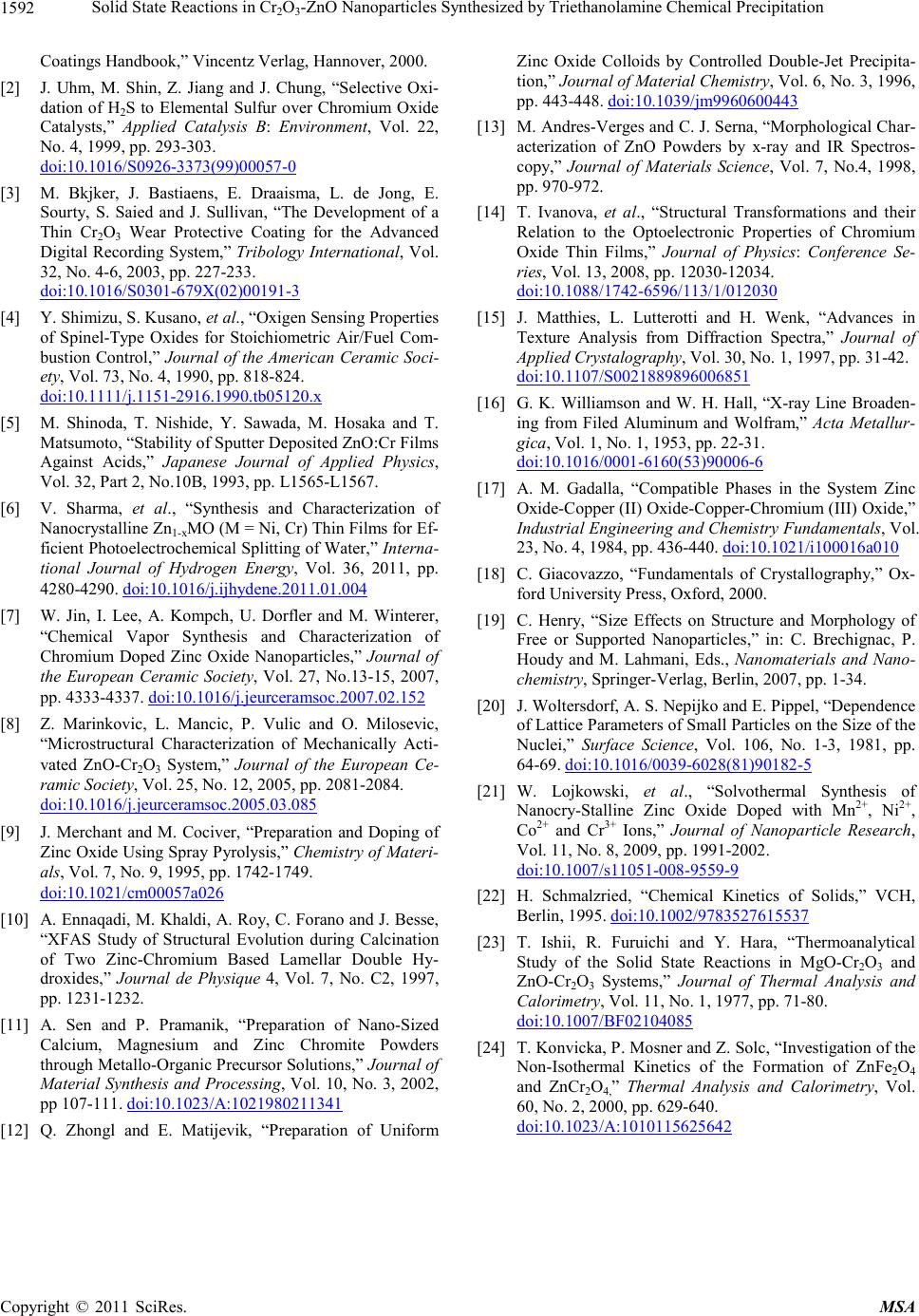
Solid State Reactions in Cr2O3-ZnO Nanoparticles Synthesized by Triethanolamine Chemical Precipitation
Copyright © 2011 SciRes. MSA
1592
Coatings Handbook,” Vincentz Verlag, Hannover, 2000.
[2] J. Uhm, M. Shin, Z. Jiang and J. Chung, “Selective Oxi-
dation of H2S to Elemental Sulfur over Chromium Oxide
Catalysts,” Applied Catalysis B: Environmen t, Vol. 22,
No. 4, 1999, pp. 293-303.
doi:10.1016/S0926-3373(99)00057-0
[3] M. Bkjker, J. Bastiaens, E. Draaisma, L. de Jong, E.
Sourty, S. Saied and J. Sullivan, “The Development of a
Thin Cr2O3 Wear Protective Coating for the Advanced
Digital Recording System,” Tribology International, Vol.
32, No. 4-6, 2003, pp. 227-233.
doi:10.1016/S0301-679X(02)00191-3
[4] Y. Shimizu, S. Kusano, et al., “Oxigen Sensing Properties
of Spinel-Type Oxides for Stoichiometric Air/Fuel Com-
bustion Control,” Journal of the American Ceramic Soci-
ety, Vol. 73, No. 4, 1990, pp. 818-824.
doi:10.1111/j.1151-2916.1990.tb05120.x
[5] M. Shinoda, T. Nishide, Y. Sawada, M. Hosaka and T.
Matsumoto, “Stability of Sputter Deposited ZnO:Cr Films
Against Acids,” Japanese Journal of Applied Physics,
Vol. 32, Part 2, No.10B, 1993, pp. L1565-L1567.
[6] V. Sharma, et al., “Synthesis and Characterization of
Nanocrystalline Zn1-xMO (M = Ni, Cr) Thin Films for Ef-
ficient Photoelectrochemical Splitting of Water,” Interna-
tional Journal of Hydrogen Energy, Vol. 36, 2011, pp.
4280-4290. doi:10.1016/j.ijhydene.2011.01.004
[7] W. Jin, I. Lee, A. Kompch, U. Dorfler and M. Winterer,
“Chemical Vapor Synthesis and Characterization of
Chromium Doped Zinc Oxide Nanoparticles,” Journal of
the European Ceramic Society, Vol. 27, No.13-15, 2007,
pp. 4333-4337. doi:10.1016/j.jeurceramsoc.2007.02.152
[8] Z. Marinkovic, L. Mancic, P. Vulic and O. Milosevic,
“Microstructural Characterization of Mechanically Acti-
vated ZnO-Cr2O3 System,” Journal of the European Ce-
ramic Society, Vol. 25, No. 12, 2005, pp. 2081-2084.
doi:10.1016/j.jeurceramsoc.2005.03.085
[9] J. Merchant and M. Cociver, “Preparation and Doping of
Zinc Oxide Using Spray Pyrolysis,” Chemistry of Materi-
als, Vol. 7, No. 9, 1995, pp. 1742-1749.
doi:10.1021/cm00057a026
[10] A. Ennaqadi, M. Khaldi, A. Roy, C. Forano and J. Besse,
“XFAS Study of Structural Evolution during Calcination
of Two Zinc-Chromium Based Lamellar Double Hy-
droxides,” Journal de Physique 4, Vol. 7, No. C2, 1997,
pp. 1231-1232.
[11] A. Sen and P. Pramanik, “Preparation of Nano-Sized
Calcium, Magnesium and Zinc Chromite Powders
through Metallo-Organic Precursor Solutions,” Journal of
Material Synthesis and Processing, Vol. 10, No. 3, 2002,
pp 107-111. doi:10.1023/A:1021980211341
[12] Q. Zhongl and E. Matijevik, “Preparation of Uniform
Zinc Oxide Colloids by Controlled Double-Jet Precipita-
tion,” Journal of Material Chemistry, Vol. 6, No. 3, 1996,
pp. 443-448. doi:10.1039/jm9960600443
[13] M. Andres-Verges and C. J. Serna, “Morphological Char-
acterization of ZnO Powders by x-ray and IR Spectros-
copy,” Journal of Materials Science, Vol. 7, No.4, 1998,
pp. 970-972.
[14] T. Ivanova, et al., “Structural Transformations and their
Relation to the Optoelectronic Properties of Chromium
Oxide Thin Films,” Journal of Physics: Conference Se-
ries, Vol. 13, 2008, pp. 12030-12034.
doi:10.1088/1742-6596/113/1/012030
[15] J. Matthies, L. Lutterotti and H. Wenk, “Advances in
Texture Analysis from Diffraction Spectra,” Journal of
Applied Crystalography, Vol. 30, No. 1, 1997, pp. 31-42.
do i:1 0. 11 07 / S 00 21 88 98 96 00 68 51
[16] G. K. Williamson and W. H. Hall, “X-ray Line Broaden-
ing from Filed Aluminum and Wolfram,” Acta Metallur-
gica, Vol. 1, No. 1, 1953, pp. 22-31.
do i:1 0. 10 16 / 00 01 - 61 60 (53)90 00 6- 6
[17] A. M. Gadalla, “Compatible Phases in the System Zinc
Oxide-Copper (II) Oxide-Copper-Chromium (III) Oxide,”
Industrial Engineering and Chemistry Fundamentals, Vol.
23, No. 4, 1984, pp. 436-440. doi:10.1021/i100016a010
[18] C. Giacovazzo, “Fundamentals of Crystallography,” Ox-
ford University Press, Oxford, 2000.
[19] C. Henry, “Size Effects on Structure and Morphology of
Free or Supported Nanoparticles,” in: C. Brechignac, P.
Houdy and M. Lahmani, Eds., Nanomaterials and Nano-
chemistry, Springer-Verlag, Berlin, 2007, pp. 1-34.
[20] J. Woltersdorf, A. S. Nepijko and E. Pippel, “Dependence
of Lattice Parameters of Small Particles on the Size of the
Nuclei,” Surface Science, Vol. 106, No. 1-3, 1981, pp.
64-69. doi:10.1016/0039-6028(81)90182-5
[21] W. Lojkowski, et al., “Solvothermal Synthesis of
Nanocry-Stalline Zinc Oxide Doped with Mn2+, Ni2+,
Co2+ and Cr3+ Ions,” Journal of Nanoparticle Research,
Vol. 11, No. 8, 2009, pp. 1991-2002.
do i:1 0. 10 07 / s 11 05 1 -00 8 -95 59 - 9
[22] H. Schmalzried, “Chemical Kinetics of Solids,” VCH,
Berlin, 1995. doi:10.1002/9783527615537
[23] T. Ishii, R. Furuichi and Y. Hara, “Thermoanalytical
Study of the Solid State Reactions in MgO-Cr2O3 and
ZnO-Cr2O3 Systems,” Journal of Thermal Analysis and
Calorimetry, Vol. 11, No. 1, 1977, pp. 71-80.
doi:10.1007/BF02104085
[24] T. Konvicka, P. Mosner and Z. Solc, “Investigation of the
Non-Isothermal Kinetics of the Formation of ZnFe2O4
and ZnCr2O4,” Thermal Analysis and Calorimetry, Vol.
60, No. 2, 2000, pp. 629-640.
doi:10.1023/A:1010115625642